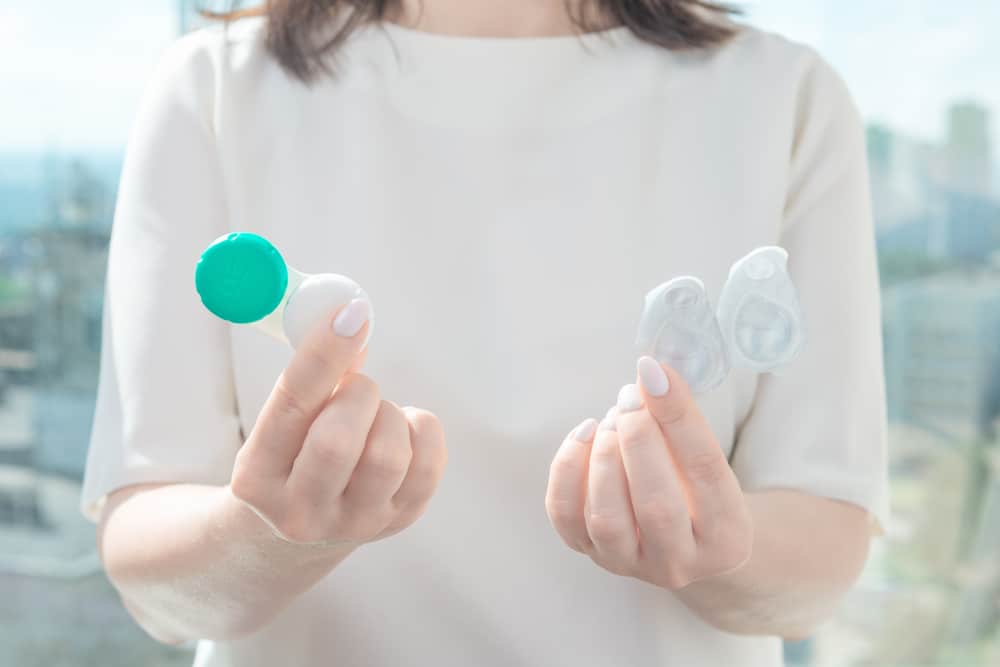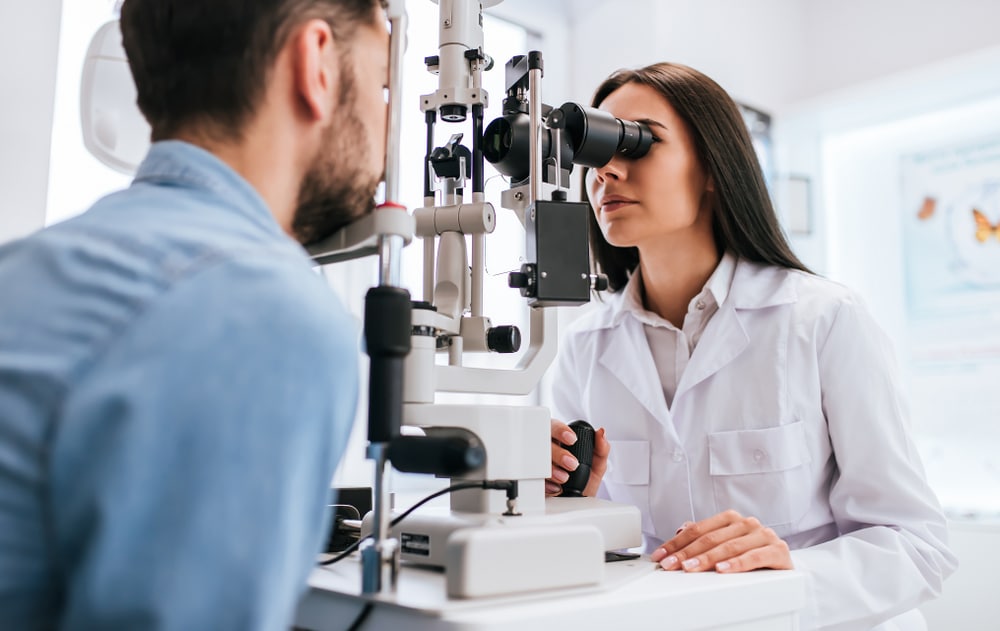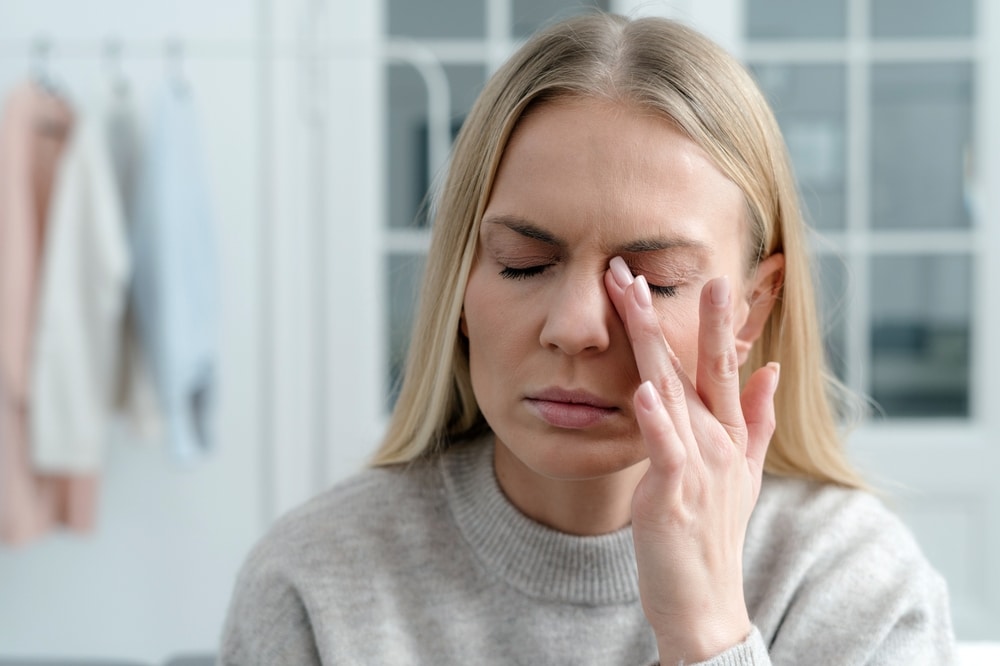A sudden, sharp, or stabbing pain in the eye can have many causes, ranging from common issues like debris in the eye to rarer, more serious conditions like glaucoma.
If you have eye pain after trauma to your eye or a burn, or sudden vision loss, you should seek medical attention immediately.
Read on for some possible causes of sharp eye pain and when you should visit a doctor.
Table of Contents
10 Common Causes of Sharp Eye Pain
Most of these causes are minor and easily treatable, but a few are very serious. Conditions like glaucoma and optic neuritis need to be addressed as soon as possible to prevent vision loss.
These are not all the possible causes of sharp eye pain. As always, if you have any unusual symptoms, you should see a doctor.
Abrasions
Abrasions are scratches on the cornea that can result from rubbing your eye when there’s a foreign body in it, wearing contact lenses for too long, being hit in the eye, or if the eye comes into contact with something like a grain of sand. Corneal abrasions can feel like there’s something under your eyelid or in your eye.
Conjunctivitis
Also known as pink eye, conjunctivitis can be a bacterial or viral infection or an allergic reaction. It causes inflammation of the membrane that protects the white of the eye and lines the eyelid. This inflammation makes the blood vessels in the membrane more visible, resulting in red or pink eyes.

Contact Lens Problems
Contact lenses can get stuck or “lost” in your eye, but they can’t go very far. Losing a contact lens in your eye can cause pain and the sensation that something is in your eye.
Here are some ways to reduce the chances of contact lenses getting lost in your eye:
- Visit an eye doctor once a year for an exam and a contact lens fitting
- Avoid sleeping in contact lenses
- Give your eyes a rest from contact lenses
- Make sure you’re buying and receiving the right contact lenses
- Follow all instructions given by your eye doctor
- Clean and store your contacts correctly
- Change contact lenses when it’s time and avoid overwearing them
Debris in the Eye
You can experience sharp pain in the eye when debris like dirt or dust gets lodged in your eye. The pain usually occurs in the area where the debris is located and may feel worse when blinking.
The pain typically goes away when you flush the debris from your eye. You can flush the affected eye with water or saline solution.
If the pain persists after the debris is removed, you may have a corneal abrasion, and you should see an eye doctor.
Dry Eyes
This condition occurs when the lacrimal glands don’t produce enough tears, or the right kind of tears, to keep the eyes properly lubricated. The eyes have three layers of tear film over them: a watery layer, an oily layer, and a mucus layer. These layers are important for clear vision and to keep the eyes clean.
Crying, taking certain medications, wearing contact lenses, and having certain medical conditions can cause the eye to dry out. Dry environments or poor air quality can also cause temporary dry eyes. When the eyes get too dry, corneal nerves become irritated, sensitive, and painful.
Dry eye symptoms include:
- Stinging
- Burning
- Redness and irritation
- Strings of mucus around the eyes
- Pain when putting on contacts
- Gritty feeling
To treat this condition, eye drops are often prescribed to help the eyes produce more tears and improve the quality of the tear.
Glaucoma
The most common type of glaucoma, open-angle glaucoma, does not cause pain in most cases. But acute-angle-closure glaucoma, also known as narrow-angle glaucoma, causes a sudden pressure change in the eye that leads to severe pain, nausea and vomiting, eye redness, and blurred vision. This condition is a medical emergency and requires immediate attention.
Eye Inflammation
Inflammation can cause pain in different areas of the eye.
Here are some of the more common types of inflammation that cause eye pain:
- Blepharitis involves the eyelids, particularly at the lid margin where the eyelashes grow
- Iritis involves the iris, the colored part of the eye
- Keratitis involves the cornea, the front surface of your eye
- Scleritis involves the white part of the eye and can be so painful that it wakes you from sleep
Eye Infection
Eye infections are often viral or bacterial and can get worse if they are not treated. Infections can result from eye injuries and from contact lenses that were not properly cleaned. Sinusitis can cause a sensation of pressure behind the eyes and cause aching and tenderness around the eye area.
Migraines
Migraines, as well as cluster and ice-pick headaches, can cause severe pain that seems to radiate from the eye. Migraines can cause severe, throbbing pain behind one or both eyes. Cluster headaches can cause extremely severe pain that occurs around one eye on one side of the head, and ice pick headaches can produce sudden stabbing pains around the eye or temple region that last for a few seconds.
Optic Neuritis
Optic neuritis is swelling of the eye’s optic nerve. This condition can be caused by the immune system attacking the optic nerve and causing damage.
Symptoms include:
- Pain when moving the eye
- Pain in the back of the eye
- Faded or dull-looking colors
- Blurred vision
- Dimming vision
The most common treatment is the use of corticosteroids. If there is an underlying condition causing optic neuritis, treating that condition can help heal the eye.

When to See a Doctor For Sharp Eye Pain
If you have severe or persistent eye pain, you should visit an eye doctor right away, as these symptoms may indicate a serious eye condition.
You should contact a doctor if you have:
- Severe eye pain
- Eye pain that does not go away after a few hours
- Visual disturbances like blurred vision or dark spots
- Visible swelling of the eye or nearby tissues
- Nausea or vomiting
You may be asked the following questions about the eye pain:
- Is it mild, intense, dull, sharp, throbbing, or stabbing?
- Does the pain feel like it’s behind your eye, in your eye, or on the surface? Is it in one or both eyes?
- Is there any redness in or around your eye? Is your eye watering? Is it swollen?
- Does it hurt more at certain times of the day—for example, right when you wake up?
- How long does the pain last—five seconds, five minutes, or longer?
- How often do you feel the pain? Once a week, once a day, or many times a day?
Schedule an Appointment at Michigan Eye Institute
MEI is dedicated to providing accessible, comprehensive vision care across our six locations in Michigan. Our expert eye doctors specialize in treating a wide variety of eye conditions, from corneal abrasions and glaucoma to dry eye and infections.
If you have any vision concerns, contact us or schedule your appointment today.
Comments are closed.



